














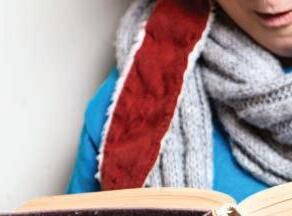






























Spark curiosity. Ignite learning. ED 2023 Issue #1 RETAIL-STYLE DISPLAYS for every age Why are librarians DITCHING DEWEY? Try our SCAVENGER HUNT
Inspiration for you, inspired by you
Welcome to the first issue of the Demco Array, a publication featuring a wide range of curated content from our expert partners and our team of Demco thought leaders. I’m absolutely delighted to bring you this collection of the best, from the brightest.
We're passionate about helping librarians and educators engage and empower the communities they serve. We’re inspired by the valuable work you do every day and the Array is another resource through which we can help support you with ideas, insights, and inspiration.
In this issue you’ll find information about creative shelving and wayfinding, fun ways to label and organize, an interview with a leading expert in library sustainability, and much more.
I hope you enjoy perusing our debut issue of the Array, and thank you for being among our first readers!
Chad Edwards, President





OUR MESSAGE
The Demco Array celebrates the role of librarians and K–12 educators in our communities while sharing an array of ideas and inspiration to help you spark curiosity, ignite learning, and transform lives.

Spark curiosity. Ignite learning.
Spark curiosity. Ignite learning.
Give your collection the attention it deserves
With ShelfSpark creative shelving solutions, you can turn your collection into an impossible-to-ignore browsing adventure that's as exciting as it is easy.






You'll grab readers' attention and they'll grab new favorites!






See the entire array of ShelfSpark products at demco.com/shelfspark














































































































































































































Signage Face-Out Display Organization In-Stack Solutions Labels Display
Show Them the Way
Establish your library as an easy place to navigate by creating the ideal visitor


CONTRIBUTORS














Amanda is an author, librarian, and educator who’s served on both the Caldecott and Newbery Award committees. She brings stories and information literacy to life through hands-on experience.

Kate has a background in nonprofit communications and is particularly interested in the ways that language drives behavior changes through education, awareness-building, and the power of an irresistible narrative.

With more than 20 years of experience in the library industry, Julie specializes in educational and library interiors. She’s passionate about empowering libraries as they move forward with reader-centered approaches.

DEMCO
855.607.4040 2
ARRAY
5
Kate Larson Writer, Researcher
Amanda Struckmeyer Library Media Specialist
Julie Hornby Library Solutions Manager, Demco
Ditching Dewey: Library Organization with a Purpose


















 by Amanda Struckmeyer
by Amanda Struckmeyer
Learn how thoughtful organization can help readers of all ages become confident, lifelong library users.

More Americans Are Reading for Pleasure


 by Kate Larson
by Kate Larson
Americans are eager to escape, explore new worlds, and get lost in a good story. How are libraries adapting?


"Sell" More Books to Every Age with Retail-Style Displays





 by Julie Hornby
by Julie Hornby



From face-out shelving to interactive displays, borrowing ideas from visual merchandising strategies can help your library gain visibility, attract patrons, and increase circulation.



Why Libraries Should Be Leaders in Sustainability









 by Kate Larson
by Kate Larson





Rebekkah Smith Aldrich, cofounder of the Sustainable Libraries Initiative (SLI), shares her thoughts on libraries' role in creating a healthier planet.







2023 ISSUE 1 DEMCO.COM 3 CONTRIBUTORS
10 14 20 30
THEMED
GENREFYING WITH BIN LABELS CHILDREN'S ACTIVITY & LITERACY CALENDARS TOP 10 WAYS TO COLOR YOUR COLLECTION CHILDREN'S LITERATURE AWARDS GET TO KNOW THE LIBRARY SCAVENGER HUNT 18 19 19 26 27 28
6
COLLECTIONS FOR YOUNG READERS







































































































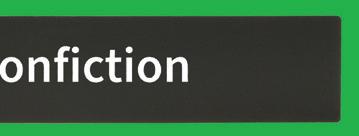



































855.607.4040 4 Bound for browsing adventures Demco® Bookshelf Signs Bring attention to the different genres in your library with attention-grabbing designs. Explore the collection at demco.com/shelfspark
Show Them the Way





















SIGNAGE IS A CRITICAL COMPONENT OF YOUR SPACE DESIGN, MERCHANDISING, AND SERVICE MODELS.




There is so much goodness happening in libraries across the country. Despite this reality, few visitors feel like they know most of what their library has to offer (not to mention those who proclaim they can find everything they need online). Wouldn’t it be great if each of these critics could be taken on a personal tour of your library? As strange as this sounds, what if everyone who stepped through your doors felt like they were on a guided tour?


Continued on next page >>
FIRST IMPRESSIONS MAKE LASTING IMPRESSIONS
Some visitors confidently proceed through your library with precise knowledge of their destination. Others scan the environment, locate a directory, and figure out their next steps. To understand what that experience is like, try doing an exercise where you pretend you’re coming into your library for the first time.
What’s your impression? Warm? Exciting? Uninspired? Confusing? What opportunities do you see to move your library toward your ideal visitor experience?
GUIDEPOSTS & BEACONS TO WHAT LIES AHEAD

The moment someone steps into your library, they want what they want— and fast. The composition of the visual elements they see can make it easier for them to find it by creating a landscape they can navigate intuitively. Assess your flooring, furnishings, and the application of color to ensure any signage you add is cohesive. Consider how you can use architectural elements such as columns, loft spaces, atriums, and “focal point” walls to enhance wayfinding. With all of this in mind, be sure to make effective use of overhead signs, ceiling or wall-mounted banners, and lettering to guide users into spaces or zones within the library. Start asking yourself questions like:
• How do the design, language choice, and placement of your communications and signs enhance the visitor experience?
• Does your real-world signage align with your library's online presence?
• Does it help visitors feel confident?
IN THE ZONE — DISCOVERING THE GOODNESS
Merchandising is a strong component of discovery. Take advantage of your resources, especially architectural elements, end panels, and canopy tops to optimize your space around a theme. Face-out displays are widely known to increase circulation, and some libraries are commingling formats on their shelving — hardcover, paperback, audio, and video in a single location. Creative shelving like this gives visitors all their options in one place and creates an opportunity for awareness of other formats or related services.
CREATE A SIGNAGE PLAN THROUGH OBSERVATION
The first step in the process of developing a wayfinding design strategy is to observe visitors to see how they maneuver through your space and where they pause to look for clues to take them to their desired destination. Repeat this process over until you have a good cross section of di erent users mapped out and represented.
Continued on next page >>
















































Guide Direct InformInstruct
Ask questions such as:




















• Are some readers less likely to stop at the reference desk to ask for help?
• Is a particular group more likely to take a less direct path?
• Do most of your visitors stop at a specific spot to gather their bearings?
• Which areas do visitors commonly need help finding?

Once you’ve gathered this data, you can decide where you currently have signage that isn’t clear, places where people are looking for signage but you don’t have any, or locations you should position communications relevant to certain groups and not others (like story time for kids).
There are six types of signs to consider when creating a signage plan: directory, primary, secondary, tertiary, collateral, and decor. Within each category there are multiple types and applications, and each serves a di erent function best. For example, directory signage might include a color-coded map or list of di erent


areas, secondary signage might help highlight help desks, self-check stations, or meeting rooms, and collateral signage might include flyers, calendars, or brochures. Through the lens of what you learned about your visitors, mark possible locations for each type of sign on a floor plan. This is a process that you may need to repeat to ensure that the result is e ective.
MEANINGFUL INTERACTIONS
Libraries are in a state of transformation, and a large component of that shift includes changing perceptions and opinions. There is no easier place to start than your current library users. The more they understand and know the full scope of what you o er, the more likely they are to become your best advocates and supporters.
Establishing your library as an easy place to navigate takes time. The approach and process you follow may include some of what is discussed in this article, but your specific roadmap and decisions will vary. Tailor your approach to your community's needs to influence how people think about your library.
To learn more about creating a signage plan, visit ideas.demco.com and search wayfinding
 Steer you in the right directionWhat you'll find over here
Steer you in the right directionWhat you'll find over here
PRIMARY TERTIARY SECONDARY DECOR COLLATERAL
Provide details and information How to do something
DIRECTORY
Overlay floor plan captures tra c patterns
Instruct
Signage hierarchy plan details e ective sign placement.









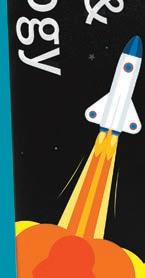
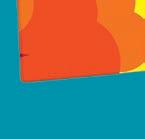
















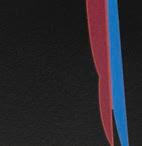















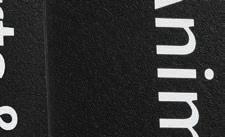






Shelves that shout, "Check me out!" Explore the collection at demco.com/shelfspark Demco® Bookshelf Dividers Spark interest and invite exploration with eye-catching dividers.
Ditching Dewey

















LIBRARY ORGANIZATION WITH A PURPOSE



















 by Amanda Struckmeyer
by Amanda Struckmeyer
THE FIRST SCHOOL LIBRARY I WORKED IN WAS ORGANIZED VERY CONVENTIONALLY, WITH PICTURE BOOKS AND FICTION SORTED ALPHABETICALLY BY THE AUTHORS’ LAST NAMES AND NONFICTION ORGANIZED BY THE DEWEY DECIMAL SYSTEM. BUT I WONDERED IF THERE WAS A BETTER WAY.







DEMCO ARRAY 10 855.607.4040
There’s nothing wrong with the traditional system, as it has been in place for years and its prevalence in public and school libraries makes it familiar; however, while the organizational tools made sense to me, they didn’t always make sense to my students. My kids wanted to know where the stories about superheroes were, regardless of the authors’ last names. Students asking where the cookbooks were stared blankly when I said, “641.5.”
I soon recognized that students were spending a lot of time asking where books were, and I was spending a lot of time finding the books for them. I also knew that my students were perfectly capable of finding what they needed if it was organized in a way that was meaningful to them. I knew I needed to make some changes, and in the process of adjusting our shelving and organization style, I learned six important lessons.
LESSON ONE IDENTIFY YOUR GOALS
My main goal as a school librarian is to help students learn to love reading. This means giving kids the tools they need to become confident, lifelong library users. We’re not in the business of teaching students the Dewey Decimal System, we’re in the business of teaching students that library resources are arranged systematically and that they are capable of learning and using that system to find what they need. Does every student need to learn that poetry books are filed under 811? Nope. But wouldn’t it be great if every student knew that poetry books are awesome and available? Yep!
LESSON TWO THINK LIKE A KID
Keep track of directional requests from students, such as:













• Where are the picture books about princesses?




• Where are the chapter books about horses?

• Where are the scary books?



• Where are the books about the Titanic?



As a librarian, I know that picture books are generally filed alphabetically by the authors’ last names, so it makes sense to me to identify the authors of princess-themed picture books and find those on the shelf. I also know that books on the Titanic can be found in several areas, including history, biography, engineering, and fiction. But most people in the world, including our students, aren’t librarians (and they don’t need to be). Groupings that make sense to non-librarians will invite students to easily access the items they’re looking for.





LESSON THREE MAKE IT EASY FOR YOURSELF AND THE KIDS
I’m a huge fan of face-out bins for easy browsing and shelving. I label each bin clearly with the topic, series, or author, and I recruit students to draw graphics for the labels. Every book that belongs in each bin bears the same call number. For example, books in our Minecraft bin are cataloged under +MIN, picture books about superheroes now bear the call number E SUP (E is for Everybody; this begins all of our picture book call numbers and signifies the physical area of the library where the book is found), and picture books about unicorns can be found under E UNI. Within the bin, the books don’t go in a specific order. This allows for easy browsing and quick shelving.
Continued on next page >>


2023 ISSUE 1 DEMCO.COM 11
Transform shelving into browsable, face-out displays. Explore more at demco.com/shelfspark
Demco® Acrylic Book Display Bin
LESSON FOUR SPARK STUDENTS' INTEREST
Along with catering to young readers’ existing interests, it’s important to create creative displays that feature lesserknown topics, themes, authors, or nonfiction subjects. Shelve these books face out and restock them as necessary. Plan out your displays to align with seasons, sports trends, student activities, and local topics of interest.
One system or process doesn’t fit every library. You’re the expert on your collection and your students’ interests, so think about what would work best and make it happen! A few ideas to consider:
• Combine picture books, readers, chapter books, graphic novels, and nonfiction books on popular topics into mini-collections. For example, you might house all your library’s books about narwhals together.
• If relocating books isn’t feasible for you, consider using color-coded star or dot spine stickers to mark popular topics. For example, you might put a pink star on the spine of every unicorn book. Be sure to post a key for students to use when looking for these highly sought-after topics!
• Ask students how they would like the library to be arranged. They often have excellent ideas and insight.
• Enlist the help of students in creating labels for shelves or bins. This o ers a new level of ownership and belonging.
LESSON FIVE START SMALL
Chances are, you could spend 24 hours a day, 7 days a week reorganizing your library, and it still might not be “finished.” Don’t sweat it; any change, no matter how small, is an effective step in the right direction. Identify realistic steps and break larger jobs into small pieces.
LESSON SIX KEEP IT FLUID
The interests of students will naturally change over time. The popularity of some materials will wane, while others will appear as new favorites. Be flexible as you try new things, and stay open to evaluating, learning from, and changing your systems.
One of the first things you’ll likely notice through this process is that the circulation of the books in thematic sections will increase. You might also see some books that previously went overlooked being checked out now that they’re more visible. And you’ll probably see students finding what they need more independently — and that is the whole idea!
DEMCO ARRAY 855.607.4040 12
You're the expert on your collection, so think about what would work best and make it happen!


































2023 ISSUE 1 13 Which way? Face out! out! Demco® Plastic Shelf-End Media Display Bin Demco® Acrylic Zig-Zag Counter/Shelf Displays Keep your most popular books and book series in plain sight. Explore the collection at demco.com/shelfspark
More Americans Are Reading for Pleasure. How Is It Reshaping Library Spaces?
 by Kate Larson
by Kate Larson
14
54 %

of readers choose their books based on the recommendation of a
Book sales were up in both 2020 and 2021, and last year libraries loaned a record number of e-books — over half a billion! Not only are people buying and borrowing more books, but the types of books they’re reading has also changed, with increased sales in adult and young adult fiction (+25%) and graphic novels (+65%). Coming out of the pandemic-spike in anxiety, Americans are eager to escape, explore new worlds, and get lost in a good story.
Library professionals are taking notice. Since reopening to the public in June 2021, “[We’ve] seen a huge increase in the number of patrons coming in for leisure reading materials,” notes Bailey Anderson, Black Earth (WI) Public Library Director. “We've also been bringing in folks that either haven't been in for a long time or ever, including younger folks and families.” Along with marketing efforts, Anderson credits “the uptick in leisure reading” as one of the drivers of this increased traffic.
How are libraries adapting to these shifts? Read on to see how Anderson and Black Earth Public Library updated their approach to embrace current trends and create a welcoming environment for all readers.
CLEARING SPACE: DECLUTTERING MAKES IT EASIER TO FALL IN LOVE WITH A NEW TITLE
With more people reading for pleasure, patrons are engaging differently with the library from the minute they walk in the door. Anderson started by clearing shelf space and updating the way collections flowed to make it easier for readers to peruse options. Many new visitors have only a theme or genre in mind; taking a merchandising approach can provide implicit guidance for their exploration.
Continued on next page >>

2023 ISSUE 1 15
THE PANDEMIC RESTRUCTURED THE WAY WE LEARN, WORK, CARE FOR FAMILY, AND ENGAGE WITH FRIENDS. IT ALSO CHANGED HOW WE READ.
family member, friend, or someone else they trust.
“Less clutter promotes organic browsing and doesn't produce as much overwhelm when patrons are not looking for something specific,” she explains.
In addition, Anderson has created a prominent display of recommended reads near the library’s entrance, and she rotates titles frequently. Patrons now go “right to the newest items when they come in the door,” she observes, “or stop on their way out and double back to check it out.” It turns out that giving books room to breathe eases pressure on library users as they hunt for their next great read.
MAKING SPACE FOR LITERARY CONVERSATIONS: WHAT LIBRARIES CAN LEARN FROM BOOKTOK
Some patrons are drawing inspiration from outside the library: specifically, from TikTok. The video-sharing app hosts a fervent community of readers (known as BookTok, a tag with over 108 billion views worldwide) who share their latest reads and recommendations. “In my opinion, BookTok is one of the biggest driving factors of increases in leisure reading, especially in younger people,” Anderson says. “I think people are definitely being more open about their reading habits and vocal about what they like about certain books or authors, or what they don't like, because even if they themselves aren't TikTok users, the trends … that originate on TikTok do trickle into other platforms and spaces.”
Taking their enthusiasm for books into their o ine lives, younger readers are now finding their way into libraries. And once they’re there, librarians can capitalize on the space to spark new conversations about books. Many libraries are using their wall and display space in eye-catching ways to get patrons talking — and reading. Others are including more BookTok-like content on their social media accounts, such as a librarian finding books to match a random prompt, suggestions for “short books to help you reach your reading goal,” and even ‘read-alikes’ for books with long hold lists.
CONNECTING THROUGH SPACE: OFFERING PERSONALIZED BOOK RECOMMENDATIONS
Once someone is at the library, librarians can offer a wealth of knowledge and experience to guide them to books they’ll love. And plenty of visitors are looking for that advice: a recent survey of America’s reading habits found that 54% of readers choose their books based on the recommendation of a family member, friend, or someone else they trust. One Black Earth staff member writes a weekly book review called “The Book Nook” for the local newspaper and, Anderson says, “I hear often from patrons that they're reading a book based on her review and recommendation.”
But the library can also be a space for readers to suggest books to each other. “Going forward, I'd like to focus more on user-generated content both digitally and in-library,” Anderson notes. “I'm hoping to be able to do more shelf-talkers that are based on reviews from patrons, posts featuring patron reviews, and an ‘Unbook Club’ type model with no required reading.” She notes that the more the library becomes a place for recommending books, the more her patrons share their ideas. Her staff has always been “extremely open about what they're reading and how they're choosing it … and modeling that behavior has created a culture in the community that's very open as well.”
DESIGNING LIBRARY SPACE FOR PATRONS WHO ARE INCREASINGLY READING FOR PLEASURE
The increase in library use, growth in book sales, and shift to lighter genres like fantasy and romance since the start of the pandemic all point to a widespread need for relaxation and connection. Fortunately, libraries continue to be a place where readers can discover new titles, chat about books, and build like-minded communities.

DEMCO ARRAY 855.607.4040 16
Less clutter promotes organic browsing and doesn't produce as much overwhelm when patrons are not looking for something specific.


































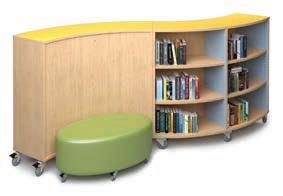

Bring your whole space to life with ColorScape® Comfortable seating Imaginative Playpods Eye-catching displays & browsers Mix-and-match shelving Modular circulation desks Explore the collection at demco.com/colorscape
Bound to Please
SIX THEMED COLLECTIONS FOR YOUNG READERS
When kids and teens are free to explore their interests and choose books that appeal to them, they’re more likely to enjoy reading — and make it a lifelong habit. While genrefying a whole library can feel overwhelming, you can start to see the benefits with just a few themed bins.
Tip: Include the appropriate age range or grade level on each bin.
For fans of...
Build enthusiasm among non-readers by sharing books about (or similar to) other media they love.
Magical reads
Curate a variety of fairytales, fables, and other enchanting stories for bedtime and beyond.
Positive vibes
In stressful times, many readers look for tales of kind-hearted characters who get a happy ending.
Art lovers
Choose picture books with stunning illustrations that can keep early and pre-readers engaged.
For the fearless
Many readers discover a love of horror in the middle grades. Offer ageappropriate options here!
Just for laughs
From fiction to poetry, funny books are some of the most memorable and well-loved.
DEMCO ARRAY 855.607.4040 18
LET KIDS MAKE THEIR MARK
Genrefying your collection and updating your approach to shelf merchandising can do a lot to encourage independent browsing. But giving kids an opportunity to get involved in the library’s transformation will give them an even stronger sense of ownership over the space, encouraging them to visit more often and engage more enthusiastically.
If you plan to organize materials into bins, invite young readers to help you make a distinctive label for each. Adjust their level of input depending on the age group participating. For example:

• Provide themed line drawings in the style of coloring books and art supplies for kids to personalize them. When they’re finished, cut out the designs and add them to the bin alongside the label you create.
• Cut out right-sized sheets with the category written in bold permanent marker or printed in block letters. Give them to kids to decorate.
• Provide right-sized sheets and assign one category to each participant. Give them free rein to create their own label from scratch — as long as it clearly incorporates the name of the category.


2023 ISSUE 1 DEMCO.COM 19
Bin Labels
FREE RESOURCE Browse a treasure trove of printable calendars full of ideas for at-home early literacy practice and librarian-led crafts, read-alouds, and seasonal activities. Visit ideas.demco.com and click Programming Calendars Daily Fun with Your Little One! TUESDAY April 2023 WEDNESDAY THURSDAY FRIDAY SATURDAY SUNDAYMONDAY © Demco, Inc. 2 16 9 23 4 18 11 25 7 21 28 14 3 17 10 24 6 20 27 13 5 19 26 12 1 8 22 15 29 30 Science Reading Sounds Play Songs Sounds Science Songs Play Math Math Play Math Songs Play Reading Science Rhymes Rhymes Math Songs Sounds Writing Writing Reading Writing Writing Science Rhymes Songs Use Geologists Day as a chance to collect different kinds of rocks and chow down on some rock candy. Don your unicorn horns and read books by Flip through a magazine or kidfriendly photo website. Point to different pictures and ask your child what they’d Turn your living room into a movie theater. Invite all your child’s stuffed animals or dolls to attend a screening. On International Jazz Day, listen to some kidfriendly jazz. Feeling inspired? Make some of your own music together. On Film Score Day, listen to music from popular movies and pretend you’re a part of the story. Ask your child to make as many animal sounds Animals Day. Are you starting to hear birds again? Talk to your child about where birds go during Work together to song like “The Wheels on the Bus.” Get out your favorite board game and invent your child. dice. Have your child roll the dice and stack the right number of blocks together. Grab 6 matching pairs of Uno cards and place them face down on the table. Turn one over, then try to find its pair. If you’re wrong, turn both face down and try again! Are you getting some April showers? Get outside and play in the puddles! Label ten pipe cleaners with numbers 1–10. Have your child string the right number of beads onto each. Challenge your child to sing her favorite song by heart. Create your own stuffed animals or animal crackers. On Pretzel Day, share the alphabet book David’s Pretzels by Helen Holder. of the freezer and put it into a bowl. Ask your child what she thinks it will look like in 10 minutes. Talk about what’s happening. On Scrabble Day, use letter tiles to spell simple words and show how changing rhyming word. Make up rhyming other and use them all day. Use animal crackers to practice simple math problems. Make up a silly song about the steps of a daily routine like getting ready for bed. Try to make each other laugh with different sounds and faces on Moment of Laughter Day. Have your child make a sign with her name on it using a different color for each letter. Make puppets out of brown paper lunch bags and put on a puppet show. Get ready for Unicorn Day tomorrow by making paper unicorn horns for your child to color and decorate. It’s World Art Day! Pull out your craft supplies In honor of Earth Day, try making homemade seed paper together. Write a rhyming poem with your child. Tuck it into her pocket for Poem in Your Pocket Day. It’s April Fool’s Day! Read April Fool! Watch Out at School! by Diane DeGroat. Help your child get ready to learn to read! Each day features a fun activity that will help your child build pre-reading skills. Activities are color-coded by skill. Ask your children’s librarian for more ideas on how to promote early literacy skills with daily activities at home.
Programming Calendars
Children's Activity Calendars Early Literacy Activity Calendars
They’re not only judging books by their covers, but also determining what they want to do at your library and how long they want to stay based on what they see and feel. Are your bookshelves and displays compelling enough to keep up?


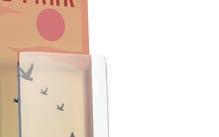


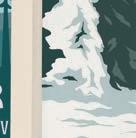


















When it comes to presentations that positively wow your customers, marketers and retailers are among your best teachers. The fact is your library patrons are consumers at heart. Visual cues like branding, placement, cohesiveness, and interactions with staff influence their “purchasing decisions” — the materials they check out or programs they attend.











In other words, clever use of your library’s shelf space and displays is your most productive and efficient “salesperson.”

FLEXIBILITY AND MOBILITY









In retail, displays change faster than the seasons. Customers respond to newness, so adaptability is key. To capture your visitors’ attention quickly and consistently, you want mobile book displays or shelves that are easy to reconfigure.



























Do you want to generate more foot traffic in another part of your library? Could you attract passersby on a nice day by temporarily moving a display outside? Shelves and displays on casters let you share a subset of your collection wherever you like, whenever you like. Put your best foot forward by organizing these mobile mini collections around popular items or your staff’s top picks.

DEMCO ARRAY 855.607.4040 20
HUMANS ARE VISUAL CREATURES, PROCESSING IMAGERY 60,000 times faster than text.
Continued on next page >>
IT STANDS TO REASON THAT YOUR LIBRARY’S VISITORS ARE MAKING A LOT OF THEIR DECISIONS based on aesthetics and appearance.
PROCESSING
"Sell" More Books to Every Age with Retail-Style Displays





















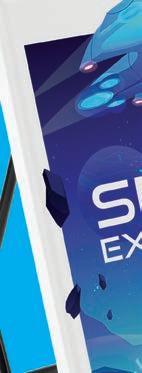
 by Julie Hornby
by Julie Hornby





































































2023 ISSUE 1 DEMCO.COM 21
Taking advantage of less obvious display areas like support beams, pillars, and other small spaces can work to your advantage. And a frequently updated digital display near the entrance of your library can draw visitors in, too. If a digital display isn’t an option, you can achieve a similar attention-grabbing system on some of your shelves — either at the front of the library or within individual genres. But one of the best changes you can make for your visitors is tailoring your displays to different age groups.
KIDS
• Get low. Make it easier for kids to browse materials themselves by decreasing your display’s height or building your own display on a lower shelf. End panels are also a prime location to do something unexpected for kids at their eye level.
to seem “hip.” Rely on teens’ input for help designing cohesive, creative displays that are about more than just their age. Try using cubes, sign holders, easels, and bookends to stand out.
ADULTS
• Location, location, location. Where do you notice adults stopping most often within your library? What are they looking for? Try to plan your displays around existing foot traffic instead of forcing new patterns.
56 %
of visitors spend less than 10 minutes in the library*
• Have fun. While kids often love educational stories, you can better capture their attention with cute, whimsical designs that make reading exciting and playful.
• Be active. Make your displays interactive with LEGO® building bricks, felt and Velcro® characters, markerboards, activity boards, and more. Encourage kids to chart their reading on a community poster.
TEENS
• Speak teenager. Teen displays need to reflect who they are and what’s important to them. Reach out to teens in your community or your teen advisory board to learn about their interests before creating displays. Rotate them regularly to touch on a wide range of popular themes.
• Lead with other media. Strategically choose non-book materials that appeal to teens’ current interests, like new video games or trending vintage TV shows. In a single display, combine these with other books on the same topic or with the same feel.
• Make it authentic. Teens can be tough critics, especially when adults try too hard
• Create some drama. Many of your patrons view going to the library the same way they view grocery shopping: they want to get in and out as quickly as possible. Utilization studies show 56% of visitors spend less than 10 minutes in the library. Your displays need stopping power. Take inspiration from local boutiques or retailers known for imaginative displays that stop people in their tracks.
• Play with scale. Having a good mix of feature displays in a range of sizes and styles creates visual interest and makes it easier for visitors to notice all the di erent materials and programming you’re highlighting.
• Stir up emotions. One of the strategies retailers have mastered is creating emotional connections. After all, if a person feels a certain way about a product, he or she is more likely to be interested in it. The same applies to getting patrons to “shop” your collection. If your displays resonate with people on an emotional level, they will stop and take a look — and perhaps go home with something unexpected. You can generate emotion with displays based on your color scheme, choice of graphics, and words.
Although the library provides many benefits and services that retailers don’t, we can learn a lot about how to build connections with “customers.” From face-out shelving to interactive displays, borrowing from successful visual merchandising strategies can help your library gain visibility, attract patrons, and increase circulation.
DEMCO ARRAY 855.607.4040 22
*The Customer Focused Library, 1 March 2012





2023 ISSUE 1 DEMCO.COM 23
Explore the collection at demco.com/shelfspark Demco® Genre Labels
been
Catch their eye as they journey by
With hundreds of new designs and customer faves, the quest for the perfect book has never
more fun.





















































































DEMCO ARRAY 855.607.4040 24 You’ve arrived at the intersection of strength & style Plain Cork Rubber Magnetic Base Styles Plain Cork Rubber Color Options Turquoise Tan Sun Drop Royal Blue Orange Zest Lime Green Ivory Iron Gray Cardinal Red Black Bahama Blue Demco® Titan™ Standard, Oversized, and StrongArm™ Steel Book Supports Explore the collection at demco.com/shelfspark
But don't take our word for it...
The bright colors add just the right touch to liven up the library.

— Librarylady2, Starr, SC
A magical product if you have metal bookshelves. Anything else slides all over the place. I will never buy any other kind again. Amazing.
— LibLady, OH
Solves a perpetual library problem! They hold long rows of books without shi ing and don’t bend out of shape or scu metal shelving. — ruestyle, Richardson, TX
Don't hesitate to order! Very bright and cheerful. They hold an entire shelf of books well.

— Marci, Idaho Falls, ID

2023 ISSUE 1 DEMCO.COM 25
T p 1 Ways t C l r Y ur C llecti n
Color coding makes it easy to keep books properly shelved, catalog materials faster, help readers quickly find books on their own, and much more. There are so many ways to color code with labels, dots, and tape. Here we’ve gathered the top ways your fellow librarians and educators use them.
4
To organize books by reading level 1
To group books by series (using a different color for each series) 2
To easily tell when items are mis-shelved 3









As borders around signs for library programming (a blue border for a children’s program, a yellow one for an adult program)
To genrefy the library 5
6 To reshelve books faster
7
8
To help keep track of book entry into inventory
To chart reading program progress
9
To organize computer and technology cords
10
To make life easier!
DEMCO ARRAY 855.607.4040 26
Children s Literature Awards
Looking to build a great display or discover some exceptional new-to-you titles? Start with the recipients of the following awards, which honor excellence in many areas: true-to-life representation of minority groups, illustration that’s inseparable from the text, sensitivity to difficult topics, translation of a book to a new language or audio format, and much more.
Alex Award
American Indian Youth Literature Awards
Américas Award
Arab American Book Award
Asian/Pacific American Award for Literature
Award for Excellence in Nonfiction for Young Adults
Award for Excellence in Poetry and Annual Notable List of Poetry Books and Verse Novels for Children
Bank Street Best Children’s Books of the Year
Carter G. Woodson Book Awards
Charlotte Huck Award®
Charlotte Zolotow Award
Children’s & Teen Choice Book Awards
Children’s Africana Book Awards
Children’s Literature Legacy Award
Christopher Awards
Coretta Scott King Book
Awards for Author and Illustrator and Coretta Scott King/John Steptoe New Talent Award
Coretta Scott King/Virginia Hamilton Lifetime Achievement Award
Cybils Award
Dolly Gray Children’s Literature Award
Excellence in Early Learning Digital Media Award
Ezra Jack Keats Book Award
First Novelist Awards — Fiction, Nonfiction, and Graphic Novel
Hans Christian Andersen Award
Irma Simonton Black and James H. Black
Award for Excellence in Children’s Literature
Jane Addams Children’s Book Awards
John Newbery Medal
Lee Bennett Hopkins Poetry Award
Malka Penn Award for Human Rights in Children’s Literature
Margaret A. Edwards Award
Mathical Book Prize
Michael L. Printz Award
Middle East Book Award
Mildred L. Batchelder Award
National Jewish Book Award
Notable Books for a Global Society
Odyssey Award
Orbis Pictus Award®
Phoenix Award
Pura Belpré Awards
Randolph Caldecott Medal
Rise: A Feminist Book Project for Ages 0-18
Robert F. Sibert Informational Book Medal
Schneider Family Book Award
Scott O’Dell Award for Historical Fiction
Skipping Stones Honor Awards
South Asia Book Awards
Stonewall Book Award — Mike Morgan & Larry Romans
Children’s & Young Adult Literature Award
Sydney Taylor Book Award
Theodor Seuss Geisel Award
Tomas Rivera Mexican American Children’s Book Award
Walter Dean Myers Award
William C. Morris Award
YALSA Award for Excellence in Nonfiction for Young Adults
2023 ISSUE 1 DEMCO.COM 27
There’s so much to explore at the library. A scavenger hunt is a great way to help your patrons get to know your spaces, sections, and collections. Try this one for fun or use it as inspiration to create your own.
Get to Know the Library
SCAVENGER HUNT
DISCOVER THE RESOURCES
Find the circulation desk
Find the reference desk
Find where you can access the library’s online catalog
Find the library book drop
Ask the librarian for a book recommendation
Find a magazine that interests you
STEP IT UP WITH SIGN-UPS AND SELFIES
Find the geography section and take a selfie with a book about a place you want to travel to
Sign up to volunteer at your library
Take a selfie with a book that has won a literary award
EXPLORE THE BOOKSHELVES
Find a book that’s part of a series
Find a historical fiction book
Find a book whose author shares your initials
Find a book at your reading level
Find a mis-shelved book




Find a book about science or technology
Find a biography


Find a book about your favorite animal
Find an audio book version of one of the print books you’ve already found

DEMCO ARRAY 855.607.4040 28


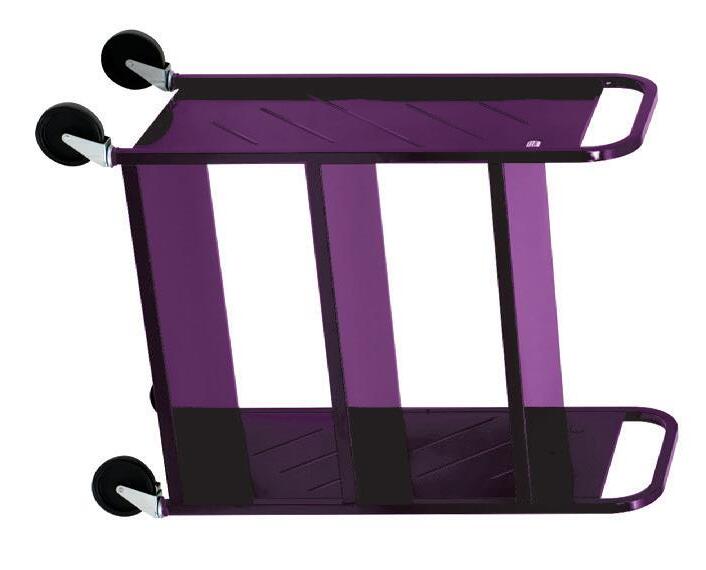





























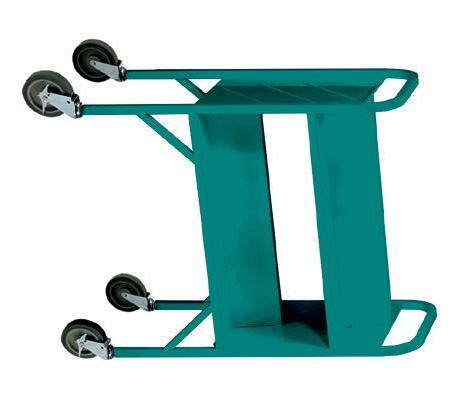













See all LibraryQuietTM Booktrucks at demco.com W i t h a s plash nda swi hhh! Read. Reshelve. Repeat.
Why Libraries Should Be Leaders in


26
“If we really start to look at what our core values are and what it looks like when we manifest those in purchasing, planning, and program decisions [...] and we start asking some honest questions, the natural course is to go down a line of sustainable thinking.”
855.607.4040
— Rebekkah Smith Aldrich
One of the most powerful forces for good in the fight against climate change is hidden in plain sight in communities across the country: our libraries. In a recent interview for Demco, Rebekkah Smith Aldrich, executive director of the Mid-Hudson Library System and cofounder of the Sustainable Libraries Initiative (SLI), shared her thoughts and answered our questions. Here's what she had to say.
by Kate Larson


WHAT DOES 'SUSTAINABILITY' MEAN IN THE CONTEXT OF LIBRARIES?


















“Sustainability encompasses much more than facilities or recycling policies. It’s not just the environment — it’s how we treat people. It’s how we spend money. It’s the choices we make every single day in almost every area of our lives. How do you live your values out loud, so even people who don’t use [the library] understand that you reflect their values? Maintaining relevance in the 21st century means facing and responding to the realities of climate change and globalization.”

Continued on next page >>
HOW CAN LIBRARIES TAKE STEPS TOWARD GREATER SUSTAINABILITY?
“Libraries are inherently sustainable; they’re designed to reduce and reuse, and by nature they support the community sharing resources. If we start small and we start making those little decisions, but we understand what the bigger picture is supposed to be, we have a better chance of getting there. Small choices, made intentionally and with a clear vision, can eventually lead to a shift in organizational culture such that sustainability is baked into library operations. If you’re going to buy it, can you buy something that’s made from recycled or biodegradable materials?
While making the shift toward sustainability, I also recommend focusing on two strategies for facing climate change: mitigation and adaptation. Mitigation means reducing overall energy consumption. Adaptation involves planning for the ways that climate change may harm your
community. Have you done disaster preparedness work for the organization? Are you ready to support the community in their own resilience before and after a disastrous natural event?”
HOW CAN LIBRARIES PROMOTE SOCIAL COHESION, A POWERFUL TOOL AGAINST CLIMATE CHANGE?
“Libraries already do an essential kind of work that equips communities to become more sustainable: they bring people together. By hosting book groups, sewing circles, LEGO® nights, and other community events, libraries are quietly doing something integral to climate adaptation, which is building stronger social ties. If we have stronger social cohesion, people are more likely to have respect, empathy, and understanding for one another and work together to solve these massive problems we’re facing.”

DEMCO ARRAY 855.607.4040 32
Small choices, made intentionally and with a clear vision, can eventually lead to a shift in organizational culture.
WHAT'S NEXT?

“The Intergovernmental Panel on Climate Change (IPCC) recently issued a report calling for immediate action to slow global temperature rise. Libraries have an essential role to play in this e ort. We all want our families to feel safe. We all want healthy places for our families to thrive. And how do libraries contribute to that? There’s no time like the present to be having this conversation.”
Demco is committed to serving the global library and education community in sustainable, ecofriendly ways. To achieve this essential goal, we work continuously to incorporate and improve environmentally friendly business practices throughout our organization.
MAKING DIFFERENTLY MAKES A DIFFERENCE

We choose local suppliers whenever possible and prioritize those who invest in sustainability.
We participate in programs like PrintReleaf to offset paper consumption through reforestation.
We use green practices from start to finish in our manufacturing plant.
We create right-sized boxes to minimize empty space and the number of parcels per shipment.
We use recycled fill to protect the product during shipment, reduce waste, and keep costs low.
We use recycled paper and recycle our white paper waste.

We use solvent-free, plant-based flexo inks and our process-free printing plates can be cleaned with soap and water.
ADDITIONAL RESOURCES ON SUSTAINABILITY
FROM THE AMERICAN LIBRARY ASSOCIATION (ALA)
Libraries and Sustainability: Programs and Practices for Community Impact
The Disaster Planning Handbook for Libraries
Sustainable Thinking: Ensuring Your Library’s Future in an Uncertain World Ecology, Economy, Equity: The Path to a Carbon-Neutral Library
The Greening of America’s Libraries: LEEDing the Way

Public Libraries and Resilient Cities
Scan for resources

2023 ISSUE 1 DEMCO.COM 33
Like you, we aim to protect OUR SHARED FUTURE

Explore the collection at demco.com/colorscape More browsing. More lounging. More learning. Invite more lounging and learning with an endlessly flexible (and lively) ColorScape® space and browsing that’s as exciting as it is easy!
browsing meets
lounging © 2023 DEMCO, INC. JO230033
Better
lively





































































































































































































































































 by Amanda Struckmeyer
by Amanda Struckmeyer


 by Kate Larson
by Kate Larson







 by Julie Hornby
by Julie Hornby












 by Kate Larson
by Kate Larson

















































































































































































 Steer you in the right directionWhat you'll find over here
Steer you in the right directionWhat you'll find over here














































































 by Amanda Struckmeyer
by Amanda Struckmeyer

































































 by Kate Larson
by Kate Larson






































































































 by Julie Hornby
by Julie Hornby


























































































































































































